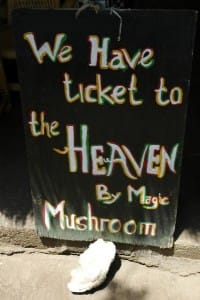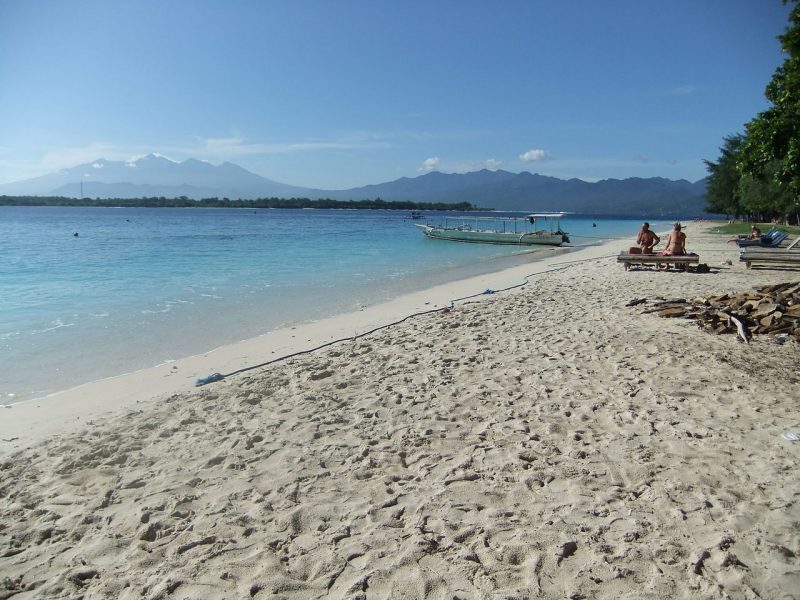Despite evidence that shows Gili Trawangan is a hub for meth and ecstasy, the Government remains mildly concerned with its role in regional drug trafficking. 
Your longboat pulls up in crystal-clear, impossibly-turquoise blue waters, and you walk the few feet across white sand to a beach-front bar. Mountain views lie across the sea, and palm trees sway behind you – you’re truly in your own Robinson-Crusoe paradise. You order a milkshake, and the friendly waiter smiles. Attempting to sell you psychoactive mushrooms in your shake, he asks, “Magic?” No, you haven’t crossed international waters. This is Gili Trawangan.
It is almost too easy to find information about drugs on ‘Gili T,’ the largest of the Nusa Tenggara Barat (NTB) islands situated between Bali and Lombok. A brief online search finds countless travel bloggers happy to reveal what you can buy, where you can buy it, and for how much on the quaint tourist-laden island. The substance scene here rivals drug hubs like Ibiza, Ko Pha Ngan, and Boracay. As we saw in April this year with the Bali Nine executions, Indonesia’s drug death penalty is not just a scare tactic, but a harsh reality. So, why is the nation’s tiniest party island so rife with drugs?
Tourists and Locals
“To be fair, all tourism destinations have the same probability for drug abuse to happen,” says Sriyanto, Chief Representative of the National Narcotics Agency (BNN) for NTB. “Drug dealers make use of crowds and traffic around tourism destinations as potential markets.” Indeed, BNN research, shared by Sriyanto with Indonesia Expat, shows that the main drugs available on Gili Trawangan are crystal methamphetamine (known to the locals as shabu), ecstasy, and mushrooms; all Class 1 Narcotics.
According to the BNN, NTB province is only 19th in Indonesia for drug abusers, and just 1.5 percent of the population uses drugs, far below the 12.8 percent 2012 national average found by the UN Office on Drugs and Crime (UNODC). But, as Sriyanto further confirms, drug abusers on Gili Trawangan are not only foreign tourists, but local citizens too.
Economic Evil
The Support for Economic Analysis Development in Indonesia project found that the gross regional domestic product per capita for the NTB province was less than half the national average in 2011. Crystal meth, the UNODC’s number-one drug of concern for Indonesia, is known to ensnare people with less disposable income. A picture begins to appear of the island’s drug problem dichotomy: on one hand, drugs are purchased on the beach by rich tourists for enjoyment as part of a once-in-a-lifetime travel experience. Meanwhile, further inland, poor locals often live with addictions to harder substances. These two sides of island life are clearly interdependent, and at this stage it’s unclear whether resolving one would affect the other at all. “It is just like the laws of commerce,” says Sriyanto. “There will always be supply as long as there is demand.”
Economics play a bigger, international role with Gili Trawangan’s drug problem. Although Sriyanto insists the island does not serve as a port for the global drug trade, there is a regional dimension to be aware of. According to Jeremy Douglas, regional representative for Southeast Asia and the Pacific at the UNODC, it is important to consider Indonesia in the context of the regional drug market and situation. “There are many trafficking organisations, sources and market destinations for drugs in Southeast Asia,” says Douglas. “Indonesia needs to prioritise collaboration with neighbouring states on a balanced mix of supply and demand reduction efforts.”
Despite this, the number of foreigners staying in classified NTB hotels almost doubled in 2013-2014, according to Statistics Agency of Indonesia. It seems the province’s tourism industry is not yet suffering the consequences of illicit drug-related activity. Sriyanto nonetheless expresses a legitimate fear that “drugs abuse and drug dealing is going to be a bad advertisement for NTB tourism, and generally for tourism in Indonesia.”
Enforcement and Education
As with many issues facing the archipelago, laws are one thing, but enforcement is another. Recent media reports claim car-free Gili Trawangan is unofficially ruled by a self-appointed local task force, the SATGAS, whose methods are often provincial. Who holds the real power is the pertinent question, and there is no clear answer: on this issue, Sriyanto would not mention the mafia, commenting only that “this matter is still on comprehensive probing [sic] by our field agents and analysts.”
There is no doubt complex hierarchies exist on Gili Trawangan, in which mutually beneficial relationships span the tourism industry, the drug trade, and local authorities. Despite a high-profile death in 2013 caused by methanol traced to one of the island’s most notorious drugs bars, Rudy’s, Gili Trawangan has so far flown under the radar in terms of a national spotlight on drugs. The result? There’s been no call to action to change interdependent relationships at work on the island. Business as usual, some say.
On a national level, Indonesia Expat reported last February that President Joko ‘Jokowi’ Widodo declared a “state of emergency” on drugs in Indonesia. The Government has not weakened its resolve that it doles out appropriate punishments to traffickers, smugglers, and dealers; as Sriyanto says, these “should be severely punished to the death penalty.”
At the same time, Indonesia is also making strides in targeting the sources of supply. Douglas confirms Indonesia has made major drug seizures recently, namely large quantities of meth. A report from the UNODC’s shows a 75 percent increase in meth seizures.
As Sriyanto affirms, however, strict national laws will not be enough. “We do not only need to eradicate the drugs trading, but also we need to send the drug abusers to rehab facilities.” To that end, he explains, the BNN in NTB has four main agenda items to tackle the issue. They include spreading awareness and prevention knowledge, empowering citizens (somehow), and working together with the BNN NTB on the overall drug problem. Finally, the agency hopes to carry out supply and demand reduction efforts by targeting dealers and promoting rehabilitation. The representative did not elaborate further on details.
Domestic education programmes may contribute to a reduction in local drug users. Only time will tell if this materialises, though for the local residents of Gili Trawangan, it’s to be hoped for. What is required is a concerted and cohesive effort from all parties, including industry, police, and governments, to tackle the regional and global drug markets. Crucially, any initiative must be reliably enforced on the ground, before Gili Trawangan declines from a once-idyllic attraction to a source of national shame.




